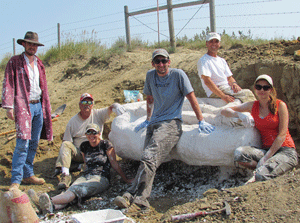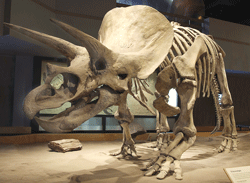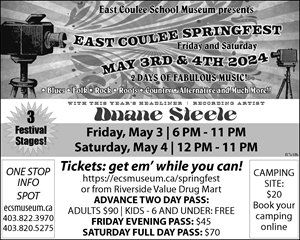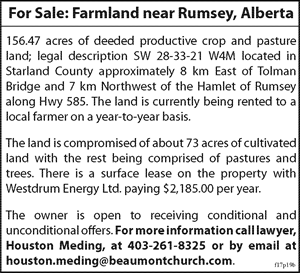
The Royal Tyrrell Museum has just wrapped up excavating a find that could help shed light on one of the mysteries about the end of the age of dinosaurs.
The specimen, believed to be the remains of a Triceratops, was found earlier this summer by a former museum employee and fossil hunter, Tim Schowalter, who then contacted the museum.
“He was keeping an eye on various outcrops, like road cuts. He spotted bones coming out of the road cut by the 571 and 854 intersection, south of Delia in the Hand Hills. He sent an email to the Tyrrell and I went out and noticed a lot more bones than in the photo he sent us,” said Dr. Francois Therrien, curator of dinosaur palaeoecology at the Tyrrell Museum.
Crews worked for 12 days in the July and August heat and found a huge concentration of bones. In the end, they came away with a jacket weighing over four tonnes. They had to bring in a truck and trailer to haul the specimen to the Tyrrell Museum.
The crew was working on the side of the road and got a few curious looks from motorists passing by.

“We would have people drive by and slow down. Some even stopped and came to see what was happening,” said Therrien.
It is hoped preparation will begin in the late fall or winter and is estimated it will take six months to prepare.
Based on shape of vertebrae, suspects it’s a large horned dinosaur and Triceratops is the only one known from that time in Alberta.
The high concentration of bones is unusual for the area. The fossils were found in a rock formation known as the Scollard Formation. The Scollard encompasses the time at the very end of the Cretaceous period.
“It turned out to be a big find for that particular rock formation. It comes from the end of the age of dinosaurs, from 67 to 66 million years ago,” said Therrien.
Generally, the Scollard Formation in the Hand Hills has very few fossils. Prior to this find, most of the finds were microfossils, which usually need a microscope to examine.
Therrien hopes the find can shed light on why there are so few large dinosaur fossils in the Scollard Formation.
“For some reason, the Scollard Formation doesn’t produce as many dinosaur fossils as the Dinosaur Park or Horseshoe Canyon Formations and we’re not sure why. Triceratops is the most common dinosaur for that time period in Montana and Saskatchewan, but not here in Alberta. We don’t know why. It could be because of environmental changes, but it could be a number of other reasons,” said Therrien.
“This specimen could offer a hint, but I think it will take a more exhaustive study of the Scollard Formation.”
Therrien has already begun looking for more fossils in the Hand Hills in hopes of finding more dinosaurs.
Anyone who finds a fossil is encouraged to contact the Tyrrell Museum at 403-823-7707 or Tyrrell.info@gov.ab.ca.



























